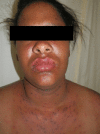Comment on: Proposal for a new diagnostic classification of photodistributed Stevens-Johnson syndrome and toxic epidermal necrolysis
- PMID: 38287381
- PMCID: PMC10823635
- DOI: 10.1186/s40001-024-01652-7
Comment on: Proposal for a new diagnostic classification of photodistributed Stevens-Johnson syndrome and toxic epidermal necrolysis
Abstract
Stevens-Johnson syndrome (SJS), toxic epidermal necrolysis (TEN), and SJS/TEN overlap (SJS/TEN), collectively referred to SJS/TEN, form a spectrum of severe life-threatening adverse drug reactions whose pathomechanism is not fully understood. The article "Photodistributed Stevens-Johnson Syndrome and Toxic Epidermal Necrolysis: A Systematic Review and Proposal for a New Diagnostic Classification" by McKinley et. al., discusses a distinct distribution of epidermal necrosis in SJS/TEN, attributable to preceding exposure to ultraviolet radiation (UVR), and relative sparing of photo-protected areas. After reviewing numerous cases within the Immune-mediated Adverse drug Reactions in African HIV endemic setting Register and Biorepository (IMARI-SA) at the University of Cape Town with a similar clinical pattern as those published by McKinley et. al., we propose that the relative sparing of some areas giving an impression of photo-distribution is due to localised increase in skin pressure that reduces the blood supply in that area below a critical threshold. A dip in blood supply below this critical threshold quantitively limited T lymphocytes and cytokines that drive SJS/TEN to reach and damage the skin.
© 2024. The Author(s).
Conflict of interest statement
The authors declare that they have no known competing financial interests or personal relationships that could have appeared to influence the work reported in this paper.
Figures
References
-
- Sotozono C, Ueta M, Nakatani E, Kitami A, Watanabe H, Sueki H, et al. Predictive factors associated with acute ocular involvement in Stevens-Johnson syndrome and toxic epidermal necrolysis. Am J Ophthalmol 2015;160(2):228-37.e2. - PubMed
-
- Roujeau J-C. Epidermal necrolysis (Stevens–Johnson syndrome and toxic epidermal necrolysis): historical considerations. Dermatol Sin. 2013;31(4):169–174. doi: 10.1016/j.dsi.2013.09.009. - DOI
-
- IMmune-mediated Adverse drug Reactions In African HIV endemic setting (IMARI-SA study): U.S. National Institutes of Health 2018. https://www.fic.nih.gov/Grants/Search/Pages/emerging-global-leader-tw011....
Publication types
MeSH terms
Substances
Grants and funding
LinkOut - more resources
Full Text Sources



